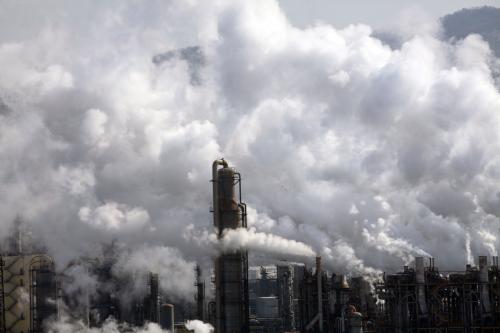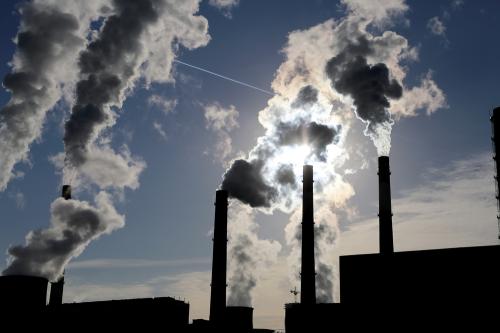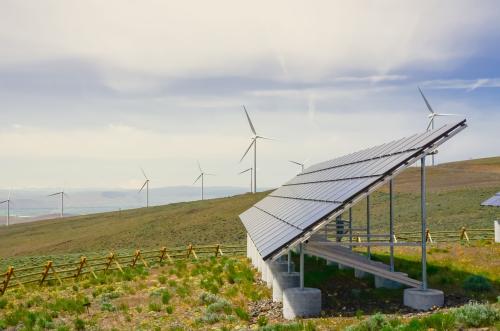A significant rise in sea levels throughout the world would have particularly devastating impacts on the concentrated urban populations living in low-lying coastal areas, affecting the local economy, politics, community life and security. Elizabeth Ferris wrote this memorandum to President Obama as part of
Big Bets and Black Swans: A Presidential Briefing Book
. Watch her related Q+A video.
- What if climate change generates a dramatic melting in the Arctic ice cap?
- Are countries ready to deal with international migration due to climate change?
- Where should climate change fit in President Obama’s foreign policy agenda?
Download Memorandum
(pdf) |
Download the Presidential Briefing Book
(pdf)
TO: President Obama
FROM: Elizabeth Ferris
Global warming is occurring at a faster pace than predicted by scientists. Temperatures are rising, icecaps and glaciers are melting, and extreme weather events are becoming both more frequent and more intense. Last fall, the National Snow and Ice Data Center documented a record low of the level of Arctic sea ice – a figure 49 percent lower than the 1979-2000 average. If these trends continue, the results will be far-reaching for life on this planet. But if the warming accelerates dramatically and if polar ice melts even faster, the results could be catastrophic. This could occur if the Greenland ice sheet or the West Antarctica Ice Sheet (WAIS) collapses, triggering a significant rise in sea levels throughout the world with particularly devastating impacts on populations living in low-lying coastal areas. Although the effects of climate change are likely to be long-term and the worst effects will probably neither be experienced in your presidency nor even in your lifetime, the future is inherently unpredictable. Climate change is already affecting communities around the world. It is likely to produce devastating consequences whether in the near or distant future. Taking bold steps now to address climate change offers an opportunity for you not only to leave a legacy that will impact future generations but also an opportunity to address current problems resulting from the effects of climate change.
Recommendations:
• Raise the priority of climate change on your foreign policy agenda, in particular by re-vitalizing negotiations over a post-Kyoto treaty. The Doha round of negotiations, which ended last month, was disappointing. Countries are further away today than they were a year ago on reducing emissions. U.S. leadership can reverse current trends of inadequate global commitment to reduce greenhouse gases.
• Support measures that will enable communities and countries to adapt to the most egregious effects of climate change. On the international level this means supporting and leading the difficult discussions around climate finance and using U.S. aid to support government planning to respond to the effects of climate change, including financial assistance to encourage communities to stay where they are as well as to plan for the relocation of communities whose homes will no longer be habitable.
• Support effective multilateral action to increase both mitigation and adaptation measures. Use your influence with the multilateral development banks to encourage more attention to disaster riskreduction measures in development planning. Work with international agencies and legal experts to devise an international legal regime for dealing with the expected increase in trans-border migration. It is easier to put a system in place before a crisis is at hand.
• Strengthen domestic efforts to mitigate the effects of climate change by reducing carbon emissions and enhancing domestic capacity to prepare for, respond, and recover from sudden-onset natural disasters.
Background:
Since the first report of the Intergovernmental Panel on Climate Change (IPCC) in 1990, the projections about the impact of global warming have become direr. From projecting the widespread consequences of a global rise in temperature of 2 degrees Celsius by the end of the century, current projections are that the rise in temperature will double to 4 degrees Celsius. The seas are rising 60 percent faster than predicted by the IPCC. The Greenland ice sheet is shrinking twice as fast as estimated by the IPCC and is losing mass at about five times the rate it was in the early 1990s. If the Greenland ice sheet were to melt completely, global sea rise could reach seven meters. And the consequences of global warming go far beyond sea-level rise. For example, the National Oceanic and Atmospheric Administration warns that the conditions that led to the 2011 Texas drought are 20 times more likely to occur now than in the 1960s as a result of increases in greenhouse gas concentrations.
Although climate change will have many negative effects in different parts of the world, including prolonged droughts, reduction in arable land, declining agricultural productivity, and increased flooding due to more extreme weather events, the impact of sea level rise perhaps best illustrates the potential dangers. Throughout the world, more people are living in coastal areas as the result of population growth, urbanization and government policies. Presently 10 percent of the world’s population — 600 million people — live in low-elevation coastal zones and the percentage is growing. Sixty-five percent of the world’s megacities (those over 5 million) are located in these coastal areas. A rise in sea level of even a meter would have major implications for coastal populations; if sea levels were to rise by several meters, the consequences would be catastrophic. Most obviously, sea level rise will submerge land, causing countries to lose physical territory. The areas expected to experience the largest land loss by 2030 are the Arctic Ocean coasts of Canada, Alaska, Siberia and Greenland as well as coastal areas of Pakistan, Sri Lanka, southeast Indonesia, and eastern Africa. In the United States, particularly vulnerable areas include the coastal areas of the east and west coasts and the Gulf of Mexico.
Rising sea levels will affect economics, politics, community life and security. For example, the mega-deltas of Asia are the food baskets of the region, and the impact of a sea level rise on food security will be considerable. But perhaps the most significant impact of climate change in general and rising sea levels in particular will be the displacement of people. Migration is a complex process driven by a range of economic, social and political factors but it is becoming clear that environmental factors will increasingly influence migration. In Bangladesh, for example, moving to cities has become a common coping strategy in the face of flooding. One of the IPCC background studies posits that a 40-centimeter rise in sea levels will affect 100 million people. As hundreds of millions of people in Africa and Asia are at risk of flooding by 2060, it is likely that many will move to cities such as Dhaka and Lagos that are located in coastal flood plain areas. In other words, the trend is for people to migrate to areas of greater — not lesser — environmental vulnerability. At the same time, as the UK’s authoritative Foresight study concludes, those who are able to migrate may well be the lucky ones; those who are unable to move may be the most vulnerable.
Large-scale migration has many consequences. If sea level rise renders small island states uninhabitable (which is likely to occur long before the islands are actually submerged by the seas), issues of sovereignty, legal status, and responsibility will present the world with huge challenges. Most climate change-induced migration or displacement will be internal, placing strain on infrastructure and pressure on governments to deliver services. Political instability, conflict and poor governance exacerbate these problems. Climate change is a threat multiplier, often affecting those countries least able to respond appropriately. How will governments cope with the movement of large numbers of people from coasts toward inland areas? There is also a possibility that some, perhaps many, will seek to move to other countries because of the effects of climate change. The international legal system is unprepared to deal with trans-border movements triggered by environmental factors or disasters, since the displaced do not fall under the 1951 Refugee Convention (unless they leave because of political turmoil exacerbated by climate change.)
Projecting possible massive displacement from climate change is complicated by the difficulty of comprehending the interrelationships between the different effects of climate change, for example, changes in fish stocks and coral reefs brought about by the acidification of the world’s oceans; changing patterns of disease; changing habitats for animals and plants; the intersection of deforestation and increasingly arid climates in some parts of the world. Delicate ecological balances are changing in ways that are as yet poorly understood. Similarly, there is much we do not know about the dynamic nature of the effects of climate change. For example, some scientists are reporting that the melting of Arctic ice itself is releasing more carbon into the atmosphere, increasing global warming which will in turn increase the rate of Arctic ice melt.
Most scientists have observed that the climate is becoming warmer and that extreme weather events are becoming more frequent. While it is impossible to attribute any single weather event, such as Hurricane Sandy, to climate change, the global trends clearly demonstrate an increase in the frequency of extreme weather events. These trends are likely to intensify. The interaction between increasing extreme weather events and other effects of climate change – such as increased erosion, acidification of the seas, desertification, sea-level rise – is also likely to lead to large-scale movement of people.
Conclusion:
There are certainly obstacles and pitfalls to making climate change a centerpiece of your foreign policy. Perhaps the projections of scientists are too pessimistic and the effects of global warming will not be as serious as now thought. Perhaps you will be unable to marshal the necessary political support to enact necessary legislation. Perhaps other governments will fail to rally to your leadership and perhaps the negotiations over climate change mitigation and adaptation will widen, not narrow the North- South divide. It is certainly understandable that you would want to put aside these longer-term challenges and focus on more immediate economic issues. But a climate catastrophe could be lurking around the corner.
Unless urgent action is taken now, the effects of climate change on life on this planet and on life in the United States will increase. Climate change is a domestic, foreign policy, security, development, human rights, and intergenerational justice issue. Preparing better for climate change disasters at home and abroad is a good short-term prophylactic. But making serious and sustained efforts to reduce global warming can solidify America’s present leadership in the world. It can lay the foundation for the country’s sustainable future development. It can address the causes of future humanitarian crises and alleviate future human suffering. It can be a legacy issue for the Obama administration that will impact the world for generations.




